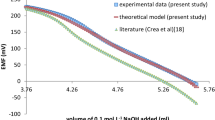Abstract
The aim of this study was to examine the possible effects of some trace metals on the inhibition of calcium oxalate crystallization. A test of urinary lithogenic risk was used to follow the crystallization of calcium oxalate from artificial urine in the presence of several metal ions assayed in their physiological concentrations. Interactions of these metal ions with known inhibitors of such crystallization (phytate, pyrophosphate, citrate and chondroitin sulphate) were also investigated. None of the metals affected the inhibition of calcium oxalate crystallization at concentrations approximating those found in normal urine, with the exception of the Fe3+ ions. Interactions of Fe3+ with some urinary components produced both synergic (phytate and pyrophosphate) and negative (citrate) effects on preventing crystallization. These effects are explained in terms of the affinity of the inhibitors for the calcium oxalate crystal surface and their ability to form stable complexes in urine. Because of the minimal concentrations, we conclude that physiological concentrations of trace elements in urine have no significant influence on calcium oxalate crystallization. In this sense, ferric ions, which exhibit an intrinsic high inhibitory capacity of calcium oxalate crystallization at physiological concentrations, even increased by the concomitant presence of phytate and pyrophosphate, are probably unable to act as powerful inhibitors in the presence of physiological urinary concentrations of citrate, due to the formation of highly stable complexes in solution without inhibitory activity.






Similar content being viewed by others
References
Grases F, Costa-Bauzá A, García-Ferragut L (1998) Biopathological crystallization: a general view about the mechanisms of renal stone formation. Adv Coll Interf Sci 74: 169
Robertson WG, Peacock M (1985) Pathogenesis of urolithiasis. In: Scheneider HJ, Peacock M, Robertson WG, Vahlensieck W (eds) Urolithiasis: etiology, diagnosis. Springer Verlag, Heidelberg New York, p 185
Fleisch H (1978) Inhibitors and promoters of stone formation. Kidney Int 13: 361
Ryall RL, Harnett RM, Marshal VR (1981) The effect of urine, pyrophosphate, citrate, magnesium and glycosaminoglycans on the growth and aggregation of calcium oxalate crystals in vitro. Clin Chim Acta 112: 349
Grases F, García-Ferragut L, Costa-Bauzá, March JG (1996) Study of the effects of different substances on the early stages of papillary stone formation. Nephron 73: 561
Meyer JL, Smith LH (1975) Growth of calcium oxalate crystals. II. Inhibition by natural crystal growth inhibitors. Invest Urol 13: 36
Hofbauer J, Steffan I, Höbarth K, Vujicic G, Schwetz H, Reich G (1991) Trace elements and urinary stone formation: new aspects of the pathological mechanism of urinary stone formation. J Urol 145: 93
Elliot JS, Ribeiro ME (1973) The urinary excretion of trace metals in patients with calcium oxalate urinary stone. Invest Urol 10: 253
Sutor DJ (1969) Growth studies of calcium oxalate in the presence of various ions and ions. Brit J Urol 41: 171
Elliot JS, Eusebio E (1967) Calcium oxalate solubility: the effect of trace metals. Invest Urol 4: 428
Eusebio E, Elliot JS (1967) Effect of trace metals on the crystallization of calcium oxalate. Invest Urol 4: 431
Welshman SG, McGeown MG (1972) A quantitative investigation of the effects of the growth of calcium oxalate crystals on potential inhibitors. Br J Urol 44: 67
Meyer JL, Angino EE (1977) The role of trace metals in calcium urolithiasis. Invest Urol 14: 347
Wolf JS, Stoller ML (1994) Inhibition of calculi fragment growth by metal-bisphosphonate complexes demonstrated with a new assay measuring the surface activity of urolithiasis inhibitors. J Urol 152: 1609
Meyer JL, Thomas WC. (1982) Trace metal-citric acid complexes as inhibitors of calcification and crystal growth. II. Efects of Fe(III), Cr(III) and Al(III) complexes on calicum oxalate crystal growth. J Urol 128: 1376
Baumann JM (1988) How to measure crystallization conditions in urine: a comparison of 7 methods. Urol Res 16: 137
Kavanagh JP (1992) Methods for the study of calcium oxalate crystallization and their application to urolithiasis research. Scanning Microsc 6: 685
Grases F, García-Ferragut L, Costa-Bauzá A, Conte A, García-Raja A (1997) Simple test to evaluate the risk of urinary calcium stone formation. Clin Chim Acta 263: 43
Grases F, Söhnel O, Costa-Bauzá A, Ramis M, Wang Z (2001) Study on concretions developed around urinary catheters and mechanisms of renal calculi development. Nephron 88: 320
Komaromy-Hiller G, Ash KO, Costa R, Howerton K (2000) Comparison of representative ranges based on US patient populations and literature reference intervals for urinary trace elements. Clin Chim Acta 296: 71
Caroli S, Alimonti A, Coni E, Petrucci F, Senofonte O, Violante N (1994) The assessment of reference values for elements in human biological tissues and fluids. A systematic review. Crit Rev Anal Chem 24: 363
Wandt MAE, Pougnet MAB (1986) Simultaneous determination of major and trace elements in urinary calculi by microwave-assisted digestion and inductively coupled plasma atomic emission spectrometric analysis. Analyst 111: 1249
Levinson AA, Nosal M, Davidman M, Prien EL, Stenvenson RG (1978) Trace elements in kidney stones from three areas in the united states. Invest Urol 15: 270
Durak I, Kilic Z, Sahin A, Akpoyraz M (1992) Analysis of calcium, iron, copper and zinc contents of nucleus and crust parts of urinary calculi. Urol Res 20: 23
Wandt MAE, Underhill LG (1988) Covariance biplot analysis of trace element concentrations in urinary stones. Br J Urol 61: 474
Marthel AE, Smith RM (1974) Critical stability constants. Plenum Press, New York
Isao Y (1994) A spectrophotometric study on the mixed-ligands complexes of Iron(III)-N-(o-hydroxybenzyl)iminodiacetate with several anions. Kenkyu Hokoku—Kumamoto Kogyo Daigaku 19: 147
Acknowledgements
J.A. Muñoz acknowledges the “Departament d’Universitats, Recerca i Societat de la Informació de la Generalitat de Catalunya” for the scholar-grant received. The work has been carried out under the support of the research Grant PPQ2002-04267-C03-01.
Author information
Authors and Affiliations
Corresponding author
Rights and permissions
About this article
Cite this article
Muñoz, J.A., Valiente, M. Effects of trace metals on the inhibition of calcium oxalate crystallization. Urol Res 33, 267–272 (2005). https://doi.org/10.1007/s00240-005-0468-4
Received:
Accepted:
Published:
Issue Date:
DOI: https://doi.org/10.1007/s00240-005-0468-4



